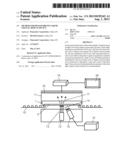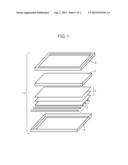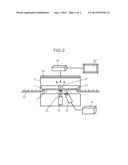Patent application title: METHOD FOR DISASSEMBLING LIQUID CRYSTAL DISPLAY DEVICE
Inventors:
Hiroshi Iwamoto (Osaka, JP)
Hiroshi Iwamoto (Osaka, JP)
Panasonic Corporation (Osaka, JP)
Assignees:
PANASONIC CORPORATION
IPC8 Class: AG01N2322FI
USPC Class:
378 45
Class name: Specific application fluorescence composition analysis
Publication date: 2013-08-01
Patent application number: 20130195242
Abstract:
In the present disclosure, before disassembly of liquid crystal module
(1) having liquid crystal panel (2) and a back light, irradiation is
performed with X-rays (13) from the front surface side of liquid crystal
panel (2) of liquid crystal module (1). By this irradiation with X-rays
(13), generated fluorescent X-rays (14) are detected to analyze an
element contained in liquid crystal panel (2), while X-rays (17)
backscattered or transmitted to the rear surface side of liquid crystal
module (1) are detected to determine a type and a state of the back
light. Then, based on the determined type and state of the back light,
liquid crystal module (1) is disassembled.Claims:
1. A method for disassembling a liquid crystal display device, the method
comprising: before disassembly of a liquid crystal module having a liquid
crystal panel and a back light, irradiating the module with X-rays from a
front surface side of the liquid crystal panel of the liquid crystal
module to detect generated fluorescent X-rays for analyzing an element
contained in the liquid crystal panel, as well as to detect X-rays
backscattered or transmitted to a rear surface side of the liquid crystal
module for determining a type and a state of the back light; and
thereafter, based on results of the analysis of the element and the
detection of the X-rays, deciding a method for disassembling the liquid
crystal module.Description:
TECHNICAL FIELD
[0001] The present disclosure relates to a method for disassembling a liquid crystal display device.
BACKGROUND ART
[0002] In recent years, as display devices appropriate for slimming and upsizing, flat-panel televisions, such as liquid crystal televisions using liquid crystal display panels and plasma televisions using plasma display panels, have been mass-produced and sales thereof have been expanded. Therewith, the number of waste of used flat-panel televisions is on the gradual increase. From viewpoints of environmental issues and resource savings, it is becoming important to improve a system for disassembling a variety of members and materials of a used flat-panel television into a recyclable form, and an efficient disassembly processing method has been required.
[0003] For example, recycling of a variety of members and materials used for a liquid crystal display device requires disassembly and classification with respect to each type of the materials. Further, a material containing a substance of concern or the like needs to be subjected to appropriate processing.
[0004] As a method for disassembling a liquid crystal display device, for example, a method disclosed in PTL 1 is hitherto known. This PTL 1 discloses a method for disassembling a waste liquid crystal display device provided with a back light. Specifically, the method for disassembling a waste liquid crystal display device is disclosed which includes the steps of: removing a cabinet from a waste liquid crystal display device; removing a control substrate from the waste liquid crystal display device, from which the cabinet has been removed; and removing a back light.
[0005] Since mercury is sealed in a fluorescent tube used for the back light of the liquid crystal display device and the fluorescent tube itself has a structure easily prone to damage, the fluorescent tube may be damaged during a disassembly operation, or may be damaged while being collected or carried. When it is damaged, there is a risk that an operator performing disassembly might breathe in mercury.
CITATION LIST
Patent Literature
[0006] PTL 1: Unexamined Japanese Patent Publication No. 2008-90225
SUMMARY
[0007] In the present disclosure, before disassembly of a liquid crystal module having a liquid crystal panel and a back light, irradiation is performed with X-rays from the front surface side of the liquid crystal panel of the liquid crystal module. By this irradiation with X-rays, generated fluorescent X-rays are detected to analyze an element contained in the liquid crystal panel, while X-rays backscattered or transmitted to the rear surface side of the liquid crystal module are detected to determine a type and a state of the back light. Then, based on the determined type and state of the back light, a method for disassembling the liquid crystal module is decided.
BRIEF DESCRIPTION OF DRAWINGS
[0008] FIG. 1 is an exploded perspective view of a liquid crystal module of a liquid crystal display device in an embodiment of the present disclosure.
[0009] FIG. 2 is an explanatory view of an inspection device for explaining a method for disassembling the liquid crystal display device in the embodiment of the present disclosure.
DESCRIPTION OF EMBODIMENT
[0010] Hereinafter, a method for disassembling a liquid crystal display device in an embodiment of the present disclosure will be described with reference to the drawings.
[0011] FIG. 1 is an exploded perspective view showing a configuration of a liquid crystal module of the liquid crystal display device in the embodiment of the present disclosure. As shown in FIG. 1, liquid crystal module 1 is configured in combination of liquid crystal panel 2, optical sheet 3, back light 4, and front outer frame 5 and rear outer frame 6 for housing them. Further, front outer frame 5 is fastened with rear outer frame 6 by screws or the like. Back light 4 is configured of a plurality of fluorescent tubes, and above this back light 4, optical sheet 3 and liquid crystal panel 2 are respectively arranged in this order.
[0012] Next, in terms of such a liquid crystal display device, there will be described a method for disassembling a used liquid crystal display device at the end of its product life.
[0013] FIG. 2 is an explanatory view showing an inspection device of liquid crystal module 1 in the disassembly method in the embodiment of the present disclosure.
[0014] First, liquid crystal module 1 is taken out of the liquid crystal display device, and placed on carrier device 10 with the liquid crystal panel 2 side turned downward. By the drive of this carrier device 10, liquid crystal module 1 is moved to an inspection section as shown in FIG. 2. At this time, X-ray shielding housing 11 descends from above for preventing leakage of X-rays.
[0015] Next, in the inspection section, irradiation is performed with X-rays 13 from X-ray source 12 located below liquid crystal module 1 toward liquid crystal panel 2. The irradiation with X-rays 13 leads to generation of fluorescent X-rays 14, and fluorescent X-rays 14 are detected by X-ray detector 15. Then, based on fluorescent X-rays 14 detected by X-ray detector 15, an element in glass of liquid crystal panel 2 is analyzed by analyzer 16. In this analysis, presence or absence of a substance of concern such as arsenic or antimony is judged while an element of a glass component and its proportion are analyzed. Then, based on this analysis, a type of glass is identified.
[0016] Further, the irradiation of liquid crystal panel 2 with X-rays 13 leads to scattering or transmission of X-rays 13 also to the rear surface side of liquid crystal module 1. These backscattered or transmitted X-rays 17 are detected by detection sensor 18. Based on X-rays 17 detected by this detection sensor 18, an image is processed by image processing device 19 and observed by monitor 20, to judge a type (fluorescent tube, LED or the like) of back light 4, and judge cracking in the fluorescent tube as back light 4.
[0017] Based on the inspection results as thus described, the materials used for liquid crystal module 1 and the type and the state, such as cracking, of back light 4 are grasped, and based on the grasped results, a subsequent disassembly process is decided. Specifically, when the fluorescent tube used for back light 4 is damaged, in order to prevent the operator from breathing in mercury during disassembly, appropriate action is taken, such as performing an operation wearing protective equipment. Further, classification is performed in accordance with a type of the glass material of liquid crystal panel 2.
[0018] As thus described, according to the embodiment of the present disclosure, before disassembly of the liquid crystal module, irradiation is performed with X-rays from the front surface side of the liquid crystal panel, and by generated fluorescent X-rays, an element contained in panel glass is analyzed. Then, presence or absence of a substance of concern is decided and a component element of panel glass and its proportion are analyzed, to identify a type of the glass, thereby allowing appropriate processing in the post-process, so as to seek a more efficient disassembly operation. Further, based on the backscattered or transmitted X-rays, the state of the back light is observed by means of an image, to judge a structure and a type of the back light and the presence or absence of cracking in the fluorescent tube used for the back light, thereby allowing selection of appropriate processing in the post-process, so as to ensure safety of the disassembly operation.
INDUSTRIAL APPLICABILITY
[0019] The present disclosure makes it possible to process a liquid crystal display device in an efficient and appropriate manner while ensuring safety of a processing operation, and is useful in recycling the liquid crystal display device.
REFERENCE MARKS IN THE DRAWINGS
[0020] 1 liquid crystal module
[0021] 2 liquid crystal panel
[0022] 3 optical sheet
[0023] 4 back light
[0024] 5 front outer frame
[0025] 6 rear outer frame
[0026] 10 carrier device
[0027] 11 X-ray shielding housing
[0028] 12 X-ray source
[0029] 13, 17 X-rays
[0030] 14 fluorescent X-rays
[0031] 15 X-ray detector
[0032] 16 analyzer
[0033] 18 detection sensor
[0034] 19 image processing device
[0035] 20 monitor
User Contributions:
Comment about this patent or add new information about this topic:
| People who visited this patent also read: | |
| Patent application number | Title |
|---|---|
| 20130317305 | REMOVABLE MEDICAL RETRACTOR TIP |
| 20130317304 | SURGICAL ACCESS SYSTEM AND RELATED METHODS |
| 20130317303 | Inflatable Surgical Retractor |
| 20130317302 | PORTABLE REGULATED VACUUM PUMP FOR MEDICAL PROCEDURES |
| 20130317301 | VAGINAL MANIPULATOR INCLUDING INDEX |



